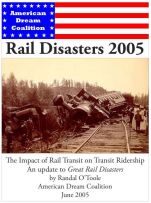
 |
|
|
(html) (2.2-mb pdf) Fact Sheet on Rail Transit
Report finds rail transit strongly associated with reduced transit ridership 
|
The Planning PenaltyHow Smart Growth Makes Housing UnaffordableSmart growth and other land-use restrictions cost U.S. homebuyers at least $275 billion in 2005. This conclusion is based on several measures of housing affordability in more than 300 metropolitan areas. The 48-page report finds that high housing prices are almost always due to government planning rules that prevent homebuilders from meeting the demand for new homes. Such rules cause prices to increase much faster than incomes, which quickly makes housing unaffordable. Special editions of the report are available for several states, including Arizona, California, Colorado, Georgia, Florida, Iowa, Minnesota, Montana, North Carolina, Oregon, South Carolina, Tennessee, Utah, Washington, and Wisconsin. These editions and briefing papers for each state reveal just what planning has done to housing affordability in dozens of metropolitan areas. How do we measure housing affordability? Several measures are described on this affordability measurements page. The report estimates that planning-induced housing shortages have added at least $100,000 to the cost of a median-value home in more than fifty metropolitan areas. This is the penalty people must pay for buying a home in a region with smart-growth planning. The penalty ranges as high as $850,000 in the San Francisco metropolitan area. In fifty more areas, planners have imposed penalties of $25,000 to $100,000 per home. The report notes that these costs are conservatively calculated and probably average at least 25 percent more. Is housing overpriced in your city or region? Find out using our pricing guide. Most planning penalties are far more than the so-called costs of sprawl. According to page 13 of The Costs of Sprawl 2000, low-density development costs about $11,000 more for urban services than compact development. Why is it better to make all homebuyers pay $25,000 to $850,000 more for homes than to make some pay $11,000?
Further InformationDataThe raw data (adjusted for inflation to 2005 dollars) and calculations used in the report are all in a downloadable spreadsheet. These data include:
Spreadsheet users can quickly and easily make charts showing changes in affordability in any metro area over time. In almost every case, affordability starts to decline soon after cities or metro areas adopt smart-growth or other growth-management plans. You can also download a spreadsheet showing the price of a "Coldwell Banker" house, i.e., a standard, 2,200-square-foot, four-bedroom, two-and-one-half bath home with a large family room and two-car garage, in hundreds of different cities across the country. Previous ResearchThe Planning Penalty shows that housing prices start rapidly growing soon after cities or regions enact smart-growth plans and estimates the costs that such plans impose on homebuyers. But previous researchers have already shown a connection between high housing prices and land-use regulation.
Although many planning advocates still deny that smart growth makes housing unaffordable, the above research has persuaded most economists that restrictive land-use regulation is the cause of unaffordable housing. Liberal economist Paul Krugman, for example, divides the country into the "Zoned Zone," where land-use restrictions make "it hard to build new houses," and what he calls "Flatland," meaning the parts of the country that may have zoning but do not have aggressive growth-management planning. Krugman's 2005 article observed that housing prices are rapidly increasing in the Zoned Zone but remain very affordable in Flatland. Is Smart Growth Need to Protect Open Space?Nearly 80 percent of Americans live in urban areas that cover just 2.6 percent of the land. Nearly 95 percent of the United States remains as rural open space. Government actions that drive up housing prices in order to preserve such an abundant resources are a tragic misplacement of priorities. Find out much of your state has been urbanized and how much rural open space is left. Download an open space spreadsheet showing what percentage of each state that has been urbanized or developed in any way and what percentage remains as rural open space. This is based on two different sources of data, the 1997 Natural Resources Inventory and the 2000 census. More information about these data is available in the discussion of open space data in the Journalists' Guide to the American Dream. Smart Growth Is InequitableActions that drive up housing prices penalize low-income families while they provide windfall profits for relatively wealthy homeowners. Nationally, nearly three out of four white families own their own homes, but more than half of black and Hispanic families live in rental housing. Homeownership is an important tool minorities and other low-income families can use to get out of poverty: they can use the equity in their homes to start small businesses. Children of low-income families that own their own homes also do better in school than those who live in rental housing. What are the homeownership rates by race in your state or metropolitan area? Download this homeownership rate spreadsheet to find out. The spreadsheet, which is from the 2000 census, also shows black, Hispanic, and Asian family incomes as a percentage of non-Hispanic white family incomes. The data show that significant disparities remain between races. Publishers of The Planning PenaltyThe Planning Penalty was jointly released by the American Dream Coalition and state groups in a number of states including:
The state reports have different covers and one page focusing on each state, but are otherwise alike. If you would like to read all the state reviews, download the report for the state that interests you most and the briefing papers for the other states. Print VersionThe reports linked above are all in color and some of the charts will be difficult to read if printed on a black-and-white or greyscale printer. Here is a version you can use if you want to print copies of the report and don't have a color printer. QuestionsQuestions about the report should be directed to its author, Randal O'Toole, an economist with the American Dream Coalition. Mr. O'Toole is also the author of The Vanishing Automobile and Other Urban Myths. Click here to order full-color copies of the Planning Penalty
|
|
|